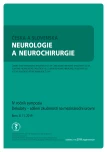The use of negative pressure wound therapy for wound complication management after vascular procedures
Authors:
M. Krejčí 1; T. Novotný 1; R. Staffa 1; P. Juřeníková 2
Authors‘ workplace:
II. chirurgická klinika, Centrum cévních onemocnění, LF MU a FN u sv. Anny v Brně
1; Katedra ošetřovatelství a porodní asistence, LF MU, Brno
2
Published in:
Cesk Slov Neurol N 2019; 82(Supplementum 1): 29-32
Category:
Original Paper
doi:
https://doi.org/10.14735/amcsnn2019S29
Overview
Aim: To evaluate the results of negative pressure wound therapy (NPWT) in the management of post-operative wound infections (Szilagyi‘s classification grade II and III) after elective arterial revascularization.
Patients and methods: Retrospective analysis of patients‘ data. All patients who were treated between 2015 and 2018 using NPWT for wound infections after elective arterial procedures on lower extremities were included.
Results: Between 2015 and 2018 a total of 13 patients have been treated using NPWT after elective infrainguinal arterial revascularization. There were nine men and four women of an average age of 72 years. Nine patients were treated for Szilagyi grade II infection (69.2%) and four patients for Szilagyi grade III infection (30.8%). In 11 cases there was an early postoperative infection (84.6%). The most common bacterial agent was Staphylococcus aureus. The minimum follow-up was 12 months. During the follow-up, the patency of arterial reconstructions was 92.3% and in 84.6% complete wound healing was achieved. The treatment success rate in the artificial graft patients‘ group was 88.9%.
Conclusion: NPWT is an effective treatment of wound infections in patients after arterial lower extremity revascularization. The method shows promising results in the management of artificial graft infection as well.
Keywords:
negative pressure wound therapy – infection – vascular surgery – vascular surgical procedure
Sources
1. Szilagyi ED, Smith RF, Elliott JP et al. Infection in arterial reconstruction with synthetic grafts. Ann Surg 1972; 176(3): 321–332. doi: 10.1097/ 00000658-197209000-00008.
2. Boateng J, Catanzano O. Advanced Therapeutic dressings for effective wound healing – a review. J Pharm Sci 2015; 104(11): 3653–3680. doi: 10.1002/ jps.24610.
3. Staffa R, Kříž Z, Vlachovský R et al. Autogenous superficial femoral vein for replacement of an infected aorto-ilio-femoral prosthetic graft. Rozhl Chir 2010; 89(1): 39–44.
4. Badretdinov IA, Pokrovsky AV. In situ aortofemoral reconstructions in surgical treatment of infected aortofemoral grafts. Angiol Sosud Khir 2015; 21(3): 173–180.
5. McGinigle KL, Pascarella L, Shortell CK et al. Spliced arm vein grafts are a durable conduit for lower extremity bypass. Ann Vasc Surg 2015; 29(4): 716–721. doi: 10.1016/ j.avsg.2014.11.013.
6. Diener H, Larena-Avellaneda A, Debus ES. Postoperative Komplikationen in der Gefässchirurgie. Chirurg 2009; 80(9): 814–826. doi: 10.1007/ s00104-009-1692-1.
7. Kuy S, Dua A, Desai S et al. Surgical site infections after lower extremity revascularization procedures involving groin incisions. Ann Vasc Surg 2014; 28(1): 53–58. doi: 10.1016/ j.avsg.2013.08.002.
8. Berríos-Torres SI, Umscheid CA, Bratzler DW et al. Centers for Disease Control and Prevention Guideline for the prevention of surgical site infection, 2017. JAMA Surg 2017; 152(8): 784–791. doi: 10.1001/ jamasurg.2017.0904.
9. Pirkl M, Daněk T, Černý M et al. Vakuová drenáž jako varianta terapie infektu cévní infrainguinální protetické rekonstrukce – zkušenosti z našeho pracoviště a shrnutí problematiky. Rozhl Chir 2013; 92(5): 237–243.
10. Suljagic V, Jevtic M, Djordjevic B et al. Surgical site infections in a tertiary health care center: prospective cohort study. Surg Today 2010; 40(8): 763–771. doi: 10.1007/ s00595-009-4124-4.
11. Antalová N, Pokorná A, Hokynková A et al. Factors influencing recurrence of the pressure ulcers after plastic surgery – retrospective analysis. Cesk Slov Neurol N 2018; 81/ 114 (Suppl 1): S23–S28.
12. Upton D, Stephens D. Andrews A. Patients‘ experiences of negative pressure wound therapy for the treatment of wounds: a review. J Wound Care 2013; 22(1): 34–39. doi: 10.12968/ jowc.2013.22.1.34.
13. Fagerdahl AM, Boström L, Ulfvarson J et al. Risk factors for unsuccessful treatment and complications with negative pressure wound therapy. Wounds 2012; 24(6): 168–177.
14. Apelqvist J, Willy C, Fagerdahl AM et al. Negative Pressure wound therapy – overview, challenges and perspectives. J Wound Care 2017; 26 (Suppl 3): S1–S154. doi: 10.12968/ jowc.2017.26.Sup3.S1.
15. Hiskett G. Clinical and economic consequences of discharge from hospital with on-going TNP therapy: a pilot study. J Tissue Viability 2010; 19(1): 16–21. doi: 10.1016/ j.jtv.2010.01.002.
16. Othman D. Negative pressure wound therapy literature review of efficacy, cost effectiveness, and impact on patients’ quality of life in chronic wound management and its implementation in the United Kingdom. Plast Surg Int 2012; 2012: 374398. doi: 10.1155/ 2012/ 374398.
17. Berger P, de Bie D, Moll FL et al. Negative pressure wound therapy on exposed prosthetic vascular grafts in the groin. J Vasc Surg 2012; 56(3): 714–720. doi: 10.1016/ j.jvs.2012.02.007.
Labels
Paediatric neurology Neurosurgery NeurologyArticle was published in
Czech and Slovak Neurology and Neurosurgery

2019 Issue Supplementum 1
Most read in this issue
- Quality of life in patient with non-healing wounds
- The knowledge and practises of nurses in the prevention of medical devices related injuries in intensive care – questionnaire survey
- The use of negative pressure wound therapy for wound complication management after vascular procedures
- Negative wound pressure therapy in treatment of a pressure ulcer in paraplegics
